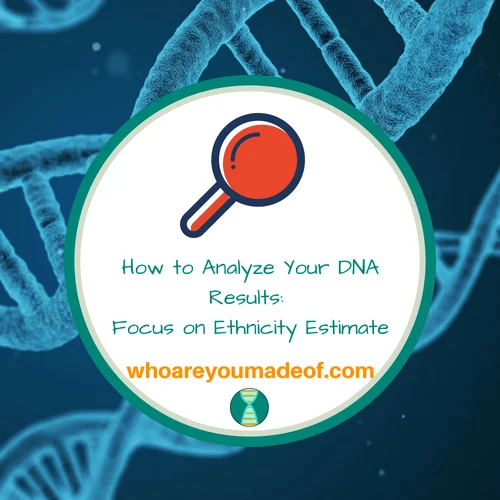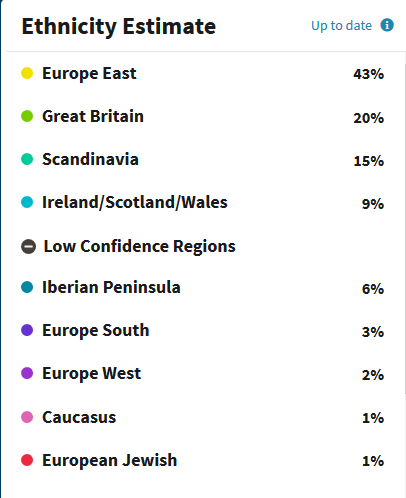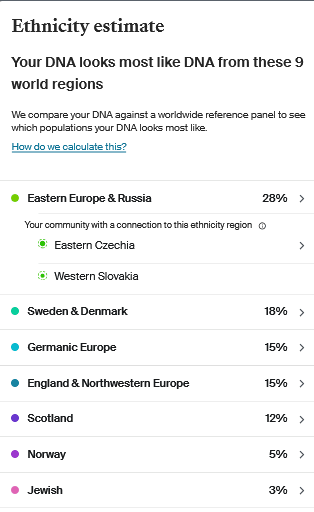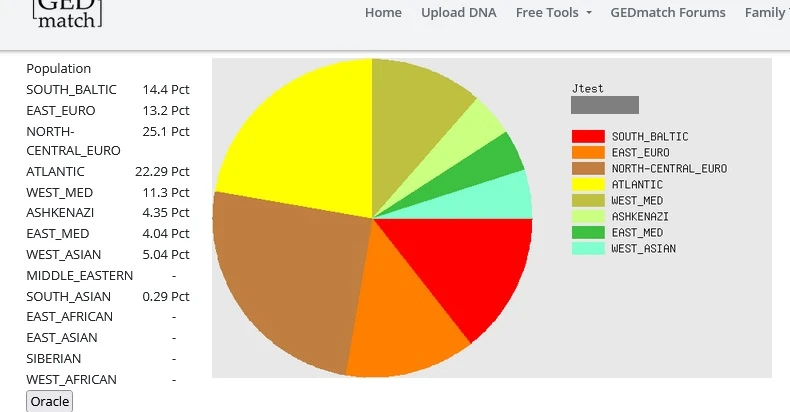If you got your DNA results back a while ago, you have probably already checked over your ethnicity estimate. You may have even looked through your first page or so of DNA matches, and everything seems in order.

Everyone says that there is so much to learn from your DNA, but how do you really know what your DNA results are trying to tell you? In this post, I’ll explain some strategies for analyzing your DNA results, with a focus on your ethnicity estimate.
Just glancing at our ethnicity estimates barely scratches the surface of what your results can reveal to you. It’s like reading those descriptions that show up in the cable television menu when you are looking for something to watch.
Do you want to know the synopsis of your family’s history, or do you want to watch the whole show? This is the difference between glancing at your results and really analyzing them.
Note: This post is written for people who have tested with any of the major autosomal DNA testing companies (23 and Me, Ancestry DNA, Family Tree DNA, and My Heritage DNA).
How to analyze your ethnicity estimate
Most people take a quick look at their ethnicity estimate and decide one of two things:
- It looks pretty accurate – nothing more to see here
- It looks completely wrong – these tests are a scam
It’s true that the first statement can be true, but if you are reading this post, you are interested in finding out for sure. If the results seem completely wrong to you, it’s okay – a closer look will help you figure out what is going on.
And if you fall somewhere in between those two statements, then a closer look is just what you need.
Steps to analyze your ethnicity estimate
If you do all of the following steps, you’ll be an expert on your own ethnicity estimate!
Step 1: Take a closer look at the ethnicity estimate that your DNA testing company provided
Are there smaller percentages of an ethnicity region that you didn’t expect to see? Keeping in mind that we only inherit 50% of each of our parent’s DNA (read: there will be some expected info “missing”), does everything seem right to you?
Ethnicity estimates are most accurate on a continent level, so if you find a percentage from an unexpected continent, there is a high probability of accuracy.
Each company defines slightly different geographic regions for each ethnicity region that they test for. Additionally, most of our ancestors probably admixed with people from nearby regions – under various circumstances – so it is very normal to show an ethnicity from a neighboring area.
For example, if you were expecting to show a lot of Irish, but instead have a lot of England and Northwestern Europe, this should not really be a surprise.
It is when the ethnicity region is far away from where you believe your ancestors are from that the results become more interesting. For example, if you were expecting Irish and find a substantial amount of Eastern European and Russia, you might want to give your family tree a second look.
Step 2: Look at the “extras” in your ethnicity estimate – if you tested with Ancestry DNA or 23 and Me
Ancestry DNA and 23 and Me provide the most in-depth ethnicity estimates, including bells and whistles. You should definitely spend some time making sure that you didn’t overlook anything important on your results.
For example, 23 and Me allows you to adjust the confidence level of your ethnicity report, and also shows you a timeline of when you might have had an ancestor who was “100%” from the regions that show up on your results.
While the timeline is only an estimate and the accuracy can vary wildly, it is still very interesting and can help you know how far back you might need to look in your family tree to find out who your ancestors were from that region.
Below is an image of where you can click on your 23 and Me results to adjust the confidence level (it is near the ethnicity “painting” on your chromosomes). You can experiment by moving the confidence level gradually.
Watch which ethnicity regions completely disappear, and which percentages drop and by how much.

Ancestry DNA’s ethnicity estimate is pretty cool, too. I find it interesting to look at the “Low Confidence Regions” to see if there are traces of ethnicities in results from long ago. The image below is from my own results.


You might notice that the first image above has some regions that are labeled “low confidence regions”. Ancestry no longer uses this terminology, but as you can see, some of those regions are still on more recent versions of my results, most notably European Jewish.
When I first did my DNA test, I was expecting to see Europe East and Great Britain in my results. I have one grandmother who is essentially 100% English, Scottish or Irish, with a smattering of very, very distant Dutch and French ancestors, and my mother’s ancestry is primarily Polish, Slovak, and German.
Naturally, I was expecting more Ireland, and no Scandinavia. This was a surprise to me, to say the least.
Based on my own research, I have determined that I probably really do have European Jewish ancestors, even though I haven’t been able to identify them. This only goes to show that you shouldn’t ignore the low percentages.
Sometimes, they can be “noise” or even incorrect, and other times, they provide a clue to a very distant ancestor (or even ancestors).
Ancestry DNA also tests you for “migrations”, which can also give you a clue as to the accuracy of your results, and whether they match what you know about your tree. For example, I knew that I had ancestors from my father’s side of the family who lived in the US during colonial and early US times.
I didn’t know this about my mother’s side of the family, however. When my mother got her DNA results back, she showed up as a match to an early US migration, which prompted me to take a closer look at a line of her tree that I had assumed was comprised of recent Irish immigrants.
The migration result was 100% accurate, and I was able to trace this line of my mother’s tree back to Massachusetts in the 1600s.
Step 3: Get a “second opinion” on your DNA ethnicity estimate
If you think you’ve spotted something that deserves a closer look, you might be interested in getting an alternative ethnicity estimate. While you could do another DNA test with a different company, this isn’t necessary in most cases.
Two of the major DNA testing companies (My Heritage DNA and Family Tree DNA) allow you to transfer your DNA results to their site. This allows you access to new DNA matches, but also ethnicity estimates.
Ethnicity estimates will always be at least slightly different from company to company (and in the case of Gedmatch, from calculator to calculator). There are several reasons for this:
- The sample population that each company uses to determine what DNA from a particular region “looks like” at a genetic level will vary. Each testing company collects DNA from sample populations who contribute their DNA in order to form a reference sample for DNA from that area. Your DNA is then compared to the reference sample in order to determine how much of your DNA is likely from that ethnicity region. Everyone has a unique family history, and so this accounts for some variation in the DNA samples that are obtained from individuals who are native to a particular region, even if their families have been there for generations. Basically, different sample populations mean different results.
- Technology used to test and compare DNA will always vary across companies. Some companies test more SNPs than others and they all have different equipment and software used to determine ethnicity and matching.
- Geographic definitions used by companies will always vary between companies. For example, some companies include Ireland in the same geographic category as the rest of Great Britain, and others recognize the genetic differences between populations that live there and include Ireland or Ireland/Scotland/Wales as separate categories.
(Read a post I wrote comparing my ethnicity estimates from four different companies)
For getting a “second opinion” on your ethnicity, or an alternative estimate, consider uploading your DNA to:
- My Heritage DNA (completely free)
- Family Tree DNA (free to upload to see DNA matches, $19 to get your myOrigins ethnicity estimate, ancient origins, and access to a chromosome browser)
- Gedmatch (completely free for most tools)
Step 4: Run your DNA through a few Admixture Calculators on Gedmatch
Gedmatch has several tools that are called “Admixture Calculators“. These calculators are designed by various independent researchers and can provide unique insights into your ethnicity estimates. These calculators are not “official” in the sense that they are generally not associated with any particular company.
They are useful because the reference panel for these calculators is determined by different sample populations. Basically, different input = different output, which gives us a slightly different perspective on our admixture.
Generally, each project and calculator combination focuses on certain population groups. There are some projects that offer best results for users with primarily European ancestry (like Eurogenes) and some that focus on those with primarily African heritage (like Ethiohelix).
I’ve been very interested in trying to trace my own Jewish ancestry lately. My original Ancestry DNA results showed almost no Ashkenazi heritage, but from the Eurogenes Jtest results (shown below), you can see that I may have as much as 4.35% European Jewish ancestry.

I have had these results verified on My Heritage and 23 and Me, as well, so I feel confident that this calculator revealed something that I could not have learned from my original Ancestry results alone – though the 1% did provide a clue that maybe I should look more closely.
Update: You might have noticed from my updated Ancestry results I posted above that my Ancestry Jewish results did increase to 3%, which I consider to be more accurately representing my family tree. Ancestry updates our DNA results about once each year as technology and research provides more accuracy.
Step 5: Ethnicity estimates are best considered along with a good family tree and DNA match evidence
One of the most common reasons that people view their ethnicity estimates as incorrect is because they don’t really have a good understanding of where all of their ancestors were from. If you haven’t built a family tree, how can you really, truly be sure where your family came from?
In my own research, I found that the family stories that I had been told growing up gave me a grossly incomplete view of my own heritage.
When I started building my tree, my goal was to learn where all of my great-great grandparents were born, even though I felt pretty sure that I already knew. It only took me a few hours to realize that I was completely mistaken about where most of my ancestors had come from.
This realization prompted my interest in DNA testing and also sparked my interest in genealogy.
To be fair to your ethnicity results, I highly recommend building a family tree in order to get a better understanding of your ethnicity results – and stay tuned for the second in this two-post series, which will discuss how to analyze your DNA results with a focus on your DNA matches. This is key to building an accurate family tree, which will help you learn even more about your roots.
Conclusion
I hope that you have learned a little about how to analyze your own DNA results from this post. If you have any questions, additional suggestions, or would like to share your own experience with DNA testing and ethnicity, I would love to hear from you in the comments below.
Thanks for stopping by today!

What is the Philippines DNA Ethnicity on Ancestry? - Who are You Made Of?
Friday 5th of March 2021
[…] if you are surprised by your Filipino DNA results, this post will help you analyze your ethnicity estimate to determine just how you might have inherited your Filipino […]